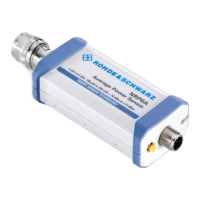R&S NRP Data acquisition and parameters (Sensor menu)
1144.1400.12 4.19 E-2
Filter / averaging
The averaging filter is used to reduce fluctuations in the measured result to the extent desired. Such
fluctuations can be caused by inherent noise of the measuring instrument, modulation of the measure-
ment signal or beats from the superposition of adjacent carriers. A more stable display has to be traded
off against longer measurements.
Note In manual mode, “longer measurements” does not mean that it takes longer to display a
new result, but rather that it takes longer for the result to settle when the power changes.
The measurement result is obtained from a two-stage averaging process. First, a measured value is
obtained for the time window specified in the Mode dialog box – either by weighted summation of sam-
ples or by integration.
Mode Sensor Time window
ContAv R&S NRP-Z1x or R&S NRP-Z2x Sampling Window (page 4.10)
Timeslot R&S NRP-Z1x or R&S NRP-Z2x Nominal Width (page 4.13)
Burst R&S NRP-Z1x or R&S NRP-Z2x Determined by the sensor according to
the signal
Gate R&S NRP-Z1x or R&S NRP-Z2x
End of Gate – Start of Gate
Measuring power in gates (page
4.14)
Measurements are continuously repeated in the selected time window. Repetitions are continuous in
the ContAv mode and trigger-controlled in the Burst, Timeslot and Scope modes. The measurement
result is obtained by averaging the measured values for the last 2N time windows. The number N is the
filter length (
Length), the factor of 2 arises because the output signals from the microwave detector to
suppress low-frequency noise are chopped at the same rate as the time windows, which means that an
independent measured value can only be obtained from two consecutive values.
The filter length can be selected automatically or can be manually set to a fixed value. As a preliminary,
you should always check if the autofilter mode is giving satisfactory results because you will always
have to adjust an optimal, manual filter-length setting if the power is not constant.
There are two autofilter operating modes.
The
Normal mode finds a balance between measurement time and display noise. Display noise can be
adjusted using the
Resolution parameter in the Windows menu ( Resolution, page 4.30). A higher reso-
lution means greater filter lengths and so longer measurements.
In the
Fixed Noise mode, the filter length is selected so that the sensor’s intrinsic noise (2 standard devia-
tions) does not exceed the specified
Noise Content. To avoid very long settling times when the power is
low, the filter length can be limited with the
Max Settling Time parameter. If the display noise then exceeds
this preset value, the symbol S/N is displayed.
SensorFilter…

